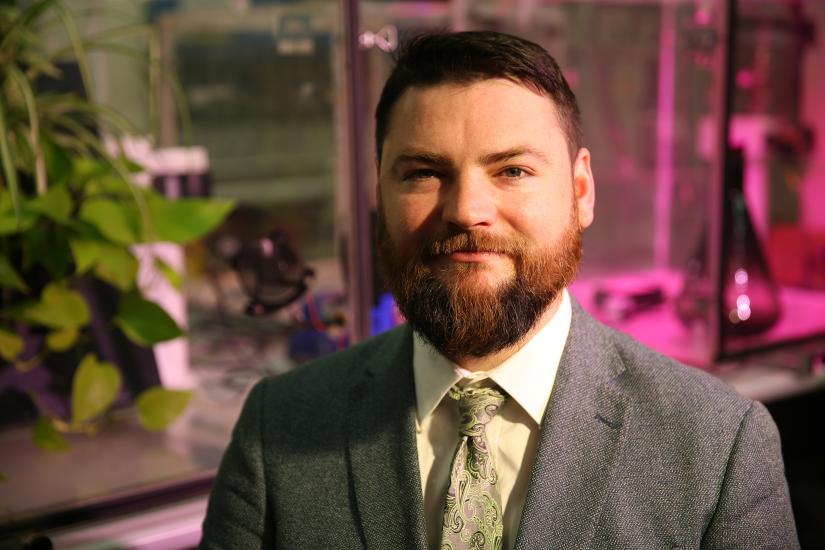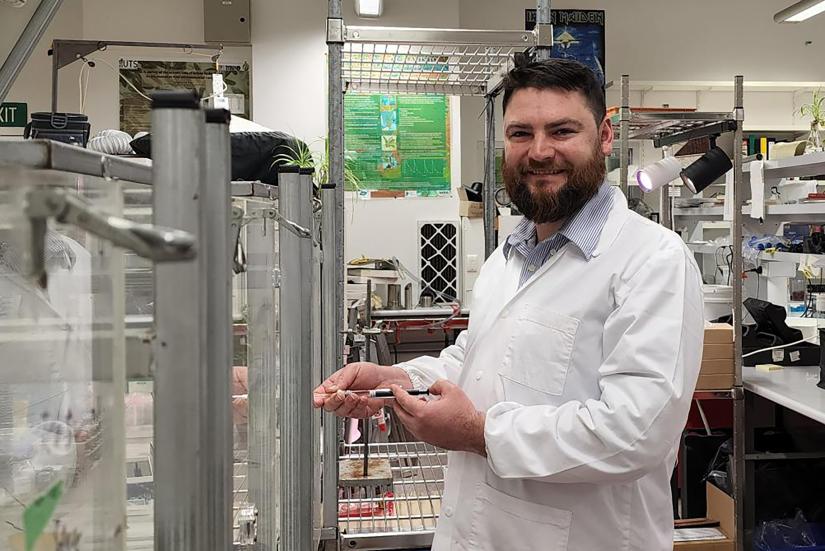Atmospheric scientist Dr Peter Irga has been recognised as a NSW Tall Poppy for 2022 for his world-leading research on indoor air pollution and the development of biological air treatment technologies to counter it. He aims to show that living infrastructure can create cities of natural beauty with happier, healthier populations.

‘Green walls and roofs can go a long way towards achieving sustainable city development’ – Dr Peter Irga. Photo by Leilah Schubert
What are your areas of expertise?
My main expertise is in air pollution and the main technologies and protocols used to monitor it. Recently, I have redirected my research focus to examine the performance of plants and botanical systems to remove air pollutants. I want to quantify the true value of these systems, and to identify areas for innovation and development.
What research are you working on currently?
I study the ability of plants, especially in green walls and roofs, to help make cities become more sustainable. That might be removing pollution from the air, creating places for animals to live, and filtering out pollution from stormwater.
Plants are known to remove air pollutants so you might be wondering why we don’t we see them being used to clean air in our cities more often. Unfortunately, they do it so slowly that the amount of plants required to observe real differences in urban air quality is sometimes impractical.
To overcome this, I have pioneered “active phytosystem biofiltration” or green walls that filter air pollutants. This innovative treatment process ducts air through a green wall, sucking polluted air through plant leaves and filtration media to remove pollution. Results are very positive to date, with high-efficiency pollution removal, significant increases in biodiversity on green roofs, and effective removal of some water pollutants.
Why is it important?
Air quality in urban settings is a long-standing issue for public health regulators and governing bodies. There is a clear need for effective air-cleaning technologies able to filter a range of pollutants in an energy-efficient manner. It is recognised by all sectors of industry and government that innovative technological solutions will be required to achieve climate resilience, sustainable urban development and local air pollution mitigation.
At the same time, expectations of increased green space and amenity value in urban environments means that air pollution mitigation technologies must be environmentally sustainable. This is reflected in many urban developers’ sustainability frameworks that require the employment of strategies to prevent pollution and demonstrate a positive impact on the environment.
I am using my research expertise in phytoremediation – especially the removal of air pollutants – to provide innovative and environmentally sustainable solutions to urban air pollution.

Air pollution expert Dr Peter Irga at work in his laboratory at UTS.
What have been your most rewarding achievements?
The research I and my team conduct is high-impact, with almost immediate benefits for the environment, society and the economy.
Seeing the research we conduct, transitioning a technology from its basic principles through to lab testing, pilot stage and extensive implementation has been immensely rewarding.
Having the research presented at the highest level of academic international conferences, including with the Food and Agriculture Organization of the United Nations, really validates the importance of the work, and having the recognition that everyone, everywhere can benefit from this technology really makes it worth it. These successes allow us to have an extended reach to promote our research, generate more collaborative partnerships with industry, and reach more people in our community.
You are recognised as a NSW Tall Poppy for 2022. What does that mean to you?
I am very appreciative of the platform that my position affords me, enabling me to promote the great research we are doing and its implications for the broader community and society.
To be recognised for my contribution to outreach activities through outreach programs, public lectures, student mentorship and generating employment opportunities is a great honour. Sharing knowledge, and helping others to also explore that knowledge, is what makes any academic pursuit worthwhile.
The Young Tall Poppy Science Award is widely considered to be an early indicator of Australia’s future scientific leaders, so this achievement is a great honour.
What comes next?
I am excited about researching and quantifying the potential for green wall technologies to embed sustainability in major infrastructure projects. For example, using air-filtering green walls in large road highways, tunnel cut-and-covers and on tunnel ventilation facilities. I believe green walls and green roofs can go a long way towards achieving sustainable city development.
Dr Peter Irga is a Chancellor's Postdoctoral Research Fellow in the School of Civil and Environmental Engineering at UTS.

